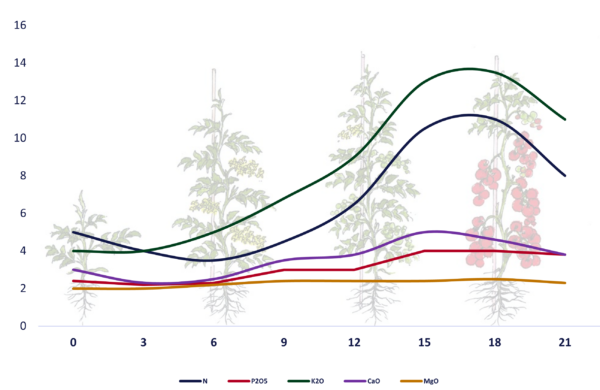Growing Tomato
Crop Nutrition Advice
Everything you need to know about tomato fertilization, best practice, suitable products, field trials and more.
Advice for growing Tomato (Solanum lycopersicum)
-
Tomatoes perform better in soil with a pH between 5.5 and 6.5.
-
In pH values above 7.5, deficiencies of B, Cu, Fe, Mn, P, and Zn are likely to appear. In soil with a pH below 5.5, tomatoes are prone to P, Mo, and Ca deficiencies.
-
Tomatoes perform best at temperatures of 18-27ºC. Temperatures 34ºC, especially under insufficient water supply.
-
Field-grown tomatoes water requirement are 4,000-6,000 m³/ha, while protected crop consumes up to 10,000 m³/ha. Water requirement is high from transplanting to fruit setting. It peaks during early fruit development and is much lower during ripening. Actually, a minor water stress during ripening stage improves fruit firmness, sugar content, taste, and shelf-life, but may result in reduced fruit size.

Freshly harvested industrial tomato
Nutrient requirements
Estimated nutrient uptake (kg/t):
| N | P2O5 | K2O | MgO | SO3 | CaO | |
|---|---|---|---|---|---|---|
| 1.3 | 0.46 | 2.9 |
Source: IPNI
Dynamic of nutrient uptake over a crop season in tomato
Role of nutrients
| Key parameter | N | P2O5 | K2O | MgO | SO3 | CaO |
|---|---|---|---|---|---|---|
| Yield | + | + | + | + | + | |
| Vegetative growth | ++ | + | + | + | + | |
| Fruit setting | - (*) | |||||
| Fruit number | + | |||||
| Fruit firmness | + | |||||
| Fruit color | + | ++ | ||||
| TSS | + |
(*) Excess of N fertilization can delay the reproductive stage
Nutrient deficiencies
| Nutrient | Description | |
|---|---|---|
| Nitrogen | General chlorosis of the older leaves on a plant. Slower growth and smaller plants; Less flowers and reduced yield | |
| Phosphorous | Plants develop very slowly, are stunted even at maturity; Brighter color than normal, lower leaf surface is grey-green. Leaflets roll upwards under severe deficiency; It occurs on calcareous and heavy soils, where P can be fixed | |
| Potassium | Symptoms appear on young, full sized leaves., margin and tip burn necrosis of the leaves. At advanced stages, necrosis shows in the interveinal spaces between the main veins, along with interveinal chlorosis. More common on light leached soils |
|
| Calcium | Necrosis of leaf base, blossom-end rot (collapsing of the distal part of the fruit). Deficiencies are severe in soils with pH below 5, salinity, heat | |
| Magnesium | Symptoms appear first on older leaves, general chlorosis while veins remain green In severe cases, scorched appearance due to interveinal necrosis. It may occur on sandy soils, and when high K rates are applied |
|
| Sulfur | Symptoms are similar to N deficiency, but the chlorosis is uniform and general throughout the entire plant, including younger leaves. Typical reddish color develops on leaves’ petioles and veins |
|
| Boron | Symptoms generally start on young leaves, as lighter color, severe deficiency shows on older leaves as interveinal chlorosis, which develops to deep yellow-orange hue. Brittle leaves that may show rolled-up edges, corky stem-end of the fruit in tomatoes |
|
| Chlorine | Abnormally shaped leaves, with distinct interveinal chlorosis, chlorosis occurs on smooth flat depressions in the interveinal area of the leaf blade. In more advanced cases there appears a characteristic bronzing on the upper side of mature leaves. It can be found in highly leached inland areas. | |
| Copper | Curled leaves, with petioles bent downward. May be expressed as a light overall chlorosis along with permanent loss of turgor in the young leaves, recently matured leaves show netted, green veining with areas bleaching to a whitish grey | |
| Iron | Iron deficiency starts out as an interveinal chlorosis of the youngest leaves, evolves into an overall chlorosis, and ends as a totally bleached leaf. Chlorosis at the base of the leaves, with some green netting, up until the time the leaves become almost completely white, they will recover upon application of iron. | |
| Manganese | At the earlier stages, light chlorosis appears on the young leaves, at more severe cases, mature leaves show netted veins. Then leaves develop brown-grey necrosis along the veins. It occurs on high-pH-, and calcareous soils, or excessively limed soils | |
| Molybdenum | An early symptom for molybdenum deficiency is overall chlorosis, very similar to nitrogen deficiency, but without the reddish coloration on the undersides of the leaves. An upward cupping of the leaves and mottled spots, developing into large interveinal chlorotic areas under severe deficiency. | |
| Zinc | It causes stunting of plants and upwards rolling of young leaves, grey-brown to bronze areas may develop on the leaves. It appears on alkaline soils, or when high P is applied |
Source: https://vikaspedia.in





